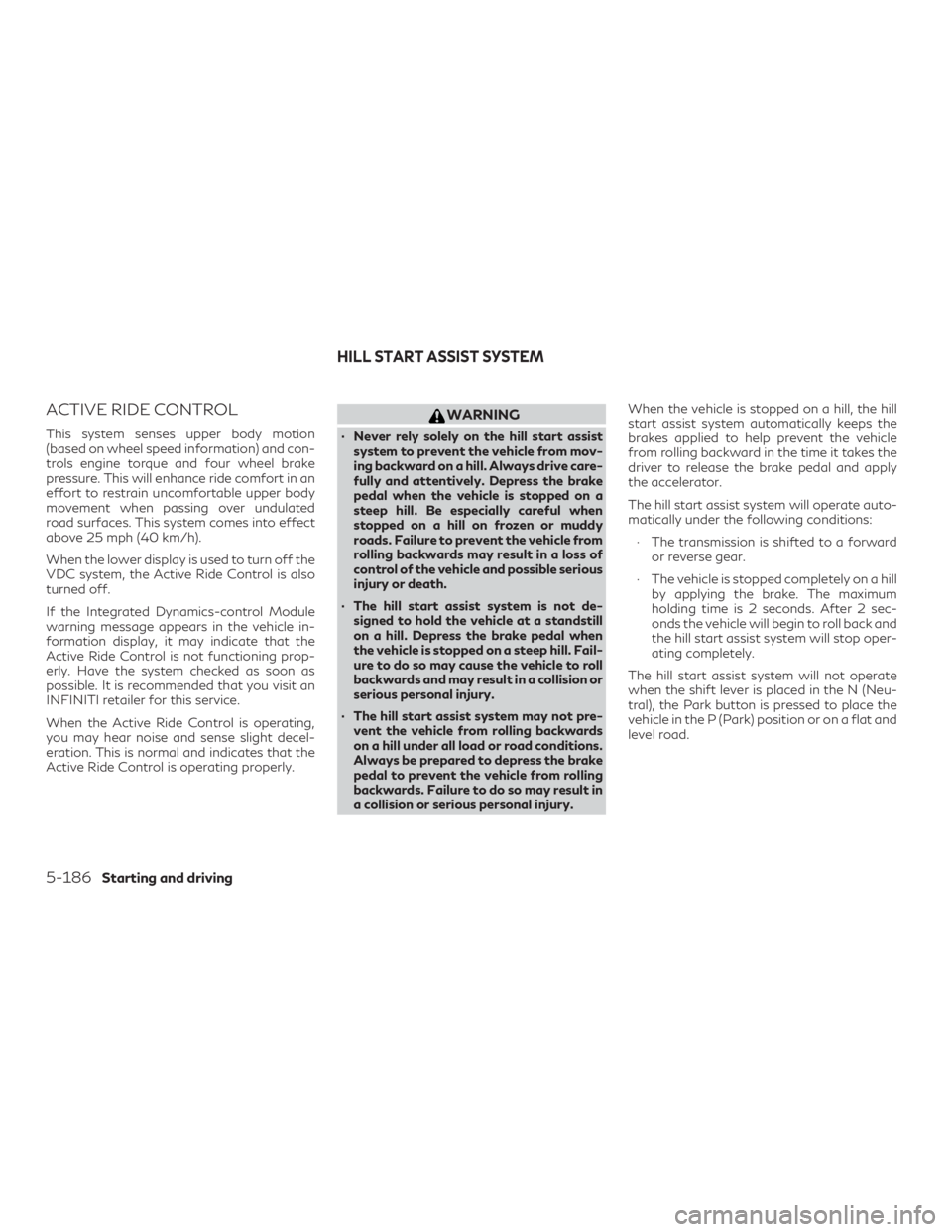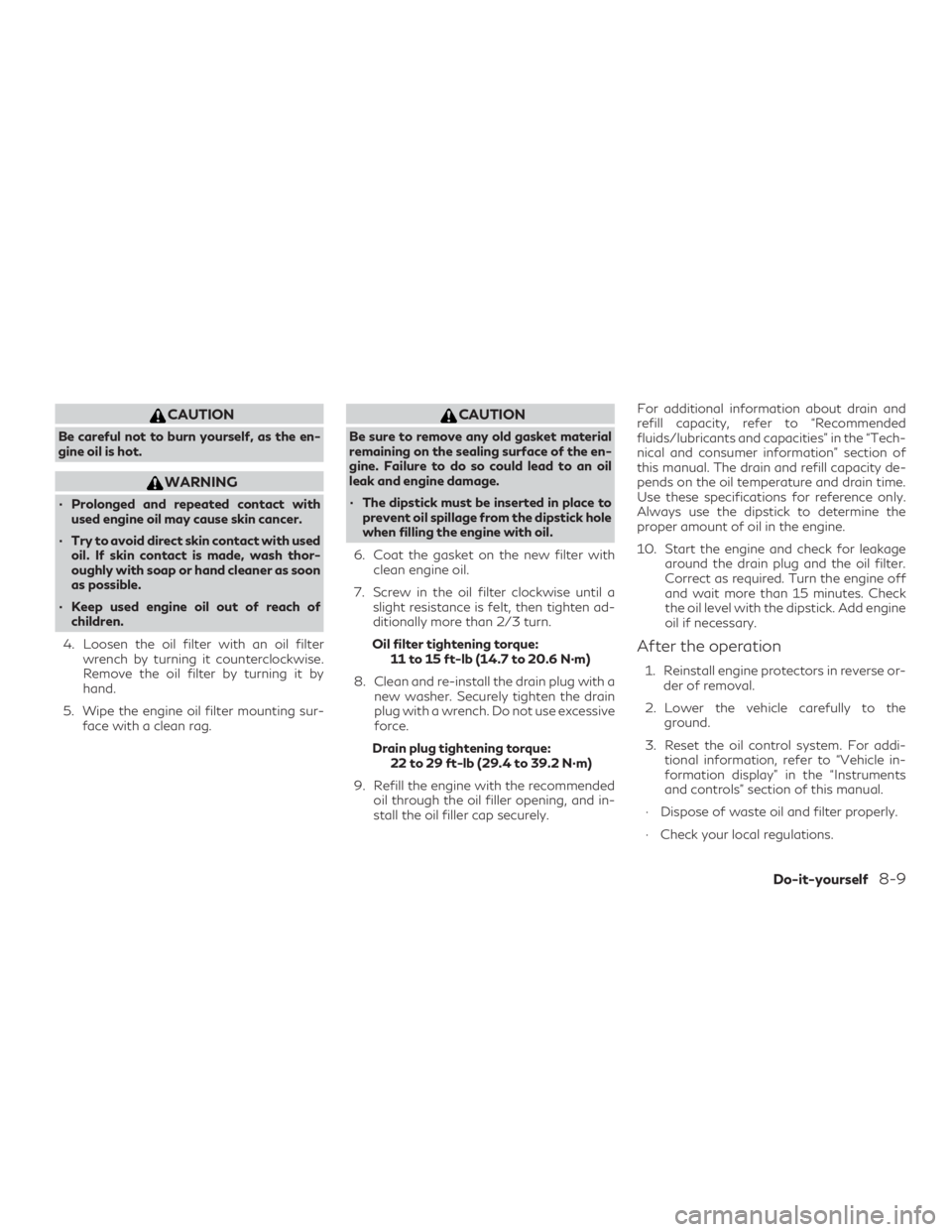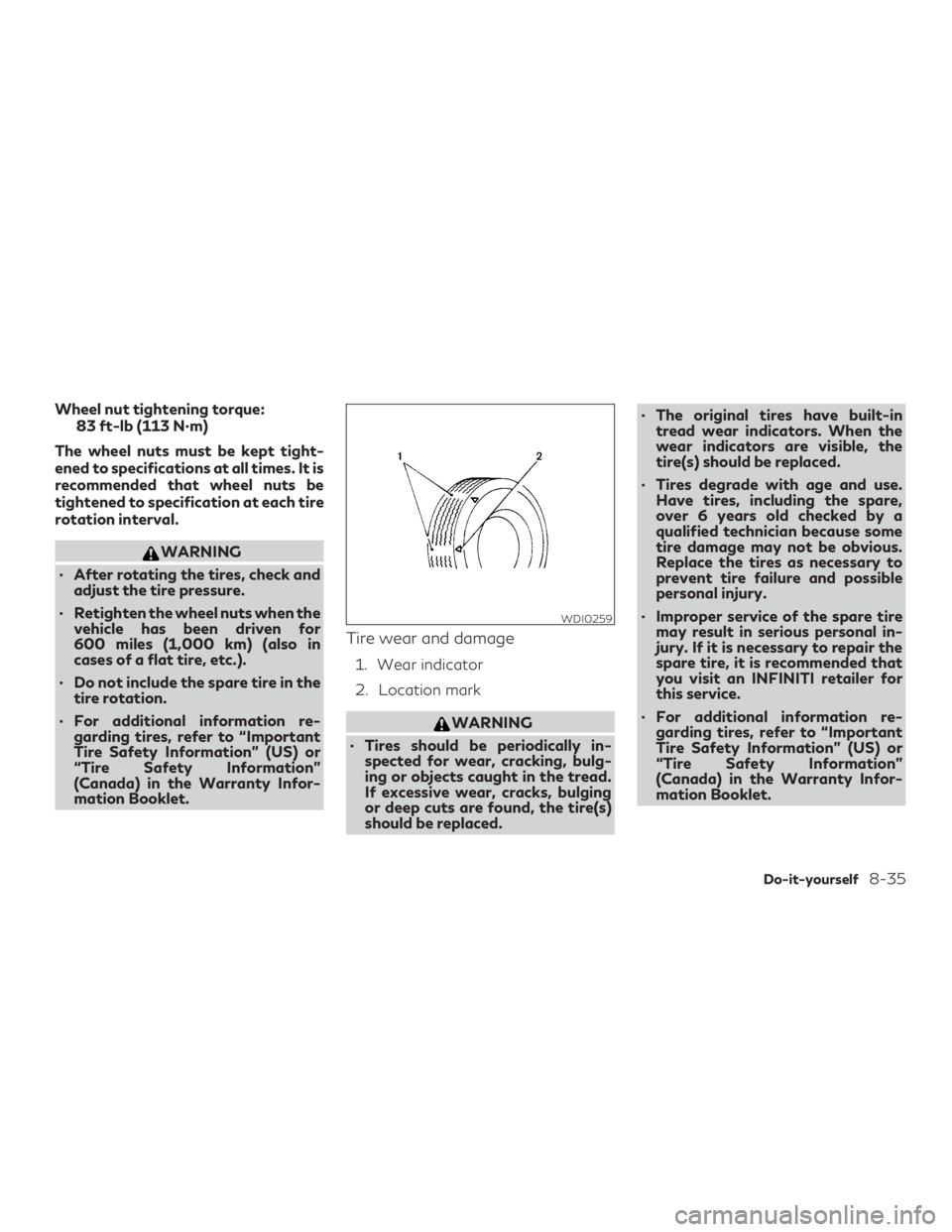torque INFINITI QX50 2020 Owner's Manual
[x] Cancel search | Manufacturer: INFINITI, Model Year: 2020, Model line: QX50, Model: INFINITI QX50 2020Pages: 580, PDF Size: 7.43 MB
Page 288 of 580

∙When the electronic parking brake is fre-
quently applied and released in a short
period of time, the parking brake may
not operate in order to prevent the park-
ing brake system from overheating. If
this occurs, operate the electronic park-
ing brake switch again after waiting ap-
proximately 1 minute.
∙ If the electronic parking brake must be
applied while driving in an emergency,
pull up and hold the parking brake
switch. When you release the parking
brake switch, the parking brake will be
released.
∙ While pulling up the electronic parking
brake switch during driving, the parking
brake is applied and a chime sounds. The
electronic parking brake indicator light
(red) in the meter and in the parking
brake switch illuminates. This does not
indicate a malfunction. The electronic
parking brake indicator light (red) in the
meter and in the parking brake switch
turns off when the parking brake is re-
leased. ∙
When pulling the electronic parking
brake switch up with the ignition switch
in the OFF or AUTO ACC position, the
parking brake switch indicator light will
continue to illuminate for a short period
of time.
WHEN TOWING A TRAILER
Depending on the weight of the vehicle and
trailer and the steepness of the slope, there
may be a tendency for the vehicle to move
backwards when starting from a standstill.
When this occurs, you can use the parking
brake switch in the same way as a conven-
tional lever type parking brake.
Before starting on sloping roads when tow-
ing a trailer, be sure to read the following to
prevent the vehicle from moving backwards
unintentionally.
∙ Release the parking brake switch as soon as the engine is delivering enough torque
to the wheels. The automatic brake hold function maintains
the braking force without the driver having to
depress the brake pedal when the vehicle is
stopped at a traffic light or intersection. As
soon as the driver depresses the accelerator
pedal again, the automatic brake hold func-
tion is deactivated and the braking force is
released. The operating status of the auto-
matic brake hold can be displayed on the
vehicle information display.
WARNING
∙ The automatic brake hold function is not
designed to hold the vehicle on a steep hill
or slippery road. Never use the automatic
brake hold when the vehicle is stopped on
a steep hill or slippery road. Failure to do
so may cause the vehicle to move.
∙ When the automatic brake hold function is activated but fails to maintain the ve-
hicle at a standstill, depress the brake
pedal to stop the vehicle. If the vehicle
unexpectedly moves due to outside con-
ditions, the chime may sound and auto-
matic brake hold warning may illuminate
in the vehicle information display.
∙ Be sure to deactivate the automatic brake hold function when using a car
wash or towing your vehicle.
AUTOMATIC BRAKE HOLD
5-26Starting and driving
Page 389 of 580

WARNING
Steering Assist is not a system for a hands-
free driving. Always keep your hands on the
steering wheel and drive your vehicle
safely. Failure to do so could cause a colli-
sion resulting in serious personal injury or
death.
NOTE:
If the driver lightly touches (instead of firmly
grips) the steering wheel, the steering
torque sensor may not detect the driver’s
hand(s) on the steering wheel and a sequence
of warnings may occur. When the driver
holds and operates the steering wheel again,
the warnings turn off.
Steering Assist limitations
WARNING
∙ In the following situations, the camera may not detect lane markers correctly or
may detect lane markers incorrectly and
the Steering Assist may not operate
properly: – When driving on roads where there
are multiple parallel lane markers, lane
markers that are faded or not painted
clearly, nonstandard lane markers, or
lane markers covered with water, dirt,
snow, etc.
– When driving on roads with discontin- ued lane markers
– When driving on roads with a widen- ing or narrowing lane width
– When driving on roads where there are multiple lanes or unclear lane
markers due to road construction
– When driving on roads where there are sharply contrasting objects, such
as shadows, snow, water, wheel ruts,
seams, or lines remaining after road
repairs (the Steering Assist could de-
tect these items as lane markers)
– When driving on roads where the traveling lane merges or separates
∙ Do not use the Steering Assist under the following conditions because the system
may not properly detect lane markers.
Doing so could cause a loss of vehicle con-
trol and result in an accident. – During bad weather (rain, fog, snow,
dust, etc.)
– When rain, snow, sand, etc., is thrown up by the wheels of other vehicles
– When dirt, oil, ice, snow, water, or an- other object adheres to the camera
unit
– When the lens of the camera unit is foggy
– When strong light (for example, sun- light or high beams from oncoming ve-
hicles) shines on the camera
– When the headlights are not bright due to dirt on the lens or the head-
lights are off in tunnels or darkness
– When a sudden change in brightness occurs (for example, when the vehicle
enters or exits a tunnel or is under a
bridge)
– When driving on roads where the traveling lane merges or separates or
where there are temporary lane mark-
ers because of road construction
– When there is a lane closure due to road repairs
Starting and driving5-127
Page 448 of 580

ACTIVE RIDE CONTROL
This system senses upper body motion
(based on wheel speed information) and con-
trols engine torque and four wheel brake
pressure. This will enhance ride comfort in an
effort to restrain uncomfortable upper body
movement when passing over undulated
road surfaces. This system comes into effect
above 25 mph (40 km/h).
When the lower display is used to turn off the
VDC system, the Active Ride Control is also
turned off.
If the Integrated Dynamics-control Module
warning message appears in the vehicle in-
formation display, it may indicate that the
Active Ride Control is not functioning prop-
erly. Have the system checked as soon as
possible. It is recommended that you visit an
INFINITI retailer for this service.
When the Active Ride Control is operating,
you may hear noise and sense slight decel-
eration. This is normal and indicates that the
Active Ride Control is operating properly.
WARNING
∙ Never rely solely on the hill start assistsystem to prevent the vehicle from mov-
ing backward on a hill. Always drive care-
fully and attentively. Depress the brake
pedal when the vehicle is stopped on a
steep hill. Be especially careful when
stopped on a hill on frozen or muddy
roads. Failure to prevent the vehicle from
rolling backwards may result in a loss of
control of the vehicle and possible serious
injury or death.
∙ The hill start assist system is not de- signed to hold the vehicle at a standstill
on a hill. Depress the brake pedal when
the vehicle is stopped on a steep hill. Fail-
ure to do so may cause the vehicle to roll
backwards and may result in a collision or
serious personal injury.
∙ The hill start assist system may not pre- vent the vehicle from rolling backwards
on a hill under all load or road conditions.
Always be prepared to depress the brake
pedal to prevent the vehicle from rolling
backwards. Failure to do so may result in
a collision or serious personal injury. When the vehicle is stopped on a hill, the hill
start assist system automatically keeps the
brakes applied to help prevent the vehicle
from rolling backward in the time it takes the
driver to release the brake pedal and apply
the accelerator.
The hill start assist system will operate auto-
matically under the following conditions:
∙ The transmission is shifted to a forward or reverse gear.
∙ The vehicle is stopped completely on a hill by applying the brake. The maximum
holding time is 2 seconds. After 2 sec-
onds the vehicle will begin to roll back and
the hill start assist system will stop oper-
ating completely.
The hill start assist system will not operate
when the shift lever is placed in the N (Neu-
tral), the Park button is pressed to place the
vehicle in the P (Park) position or on a flat and
level road.
HILL START ASSIST SYSTEM
5-186Starting and driving
Page 485 of 580

CAUTION
Be careful not to burn yourself, as the en-
gine oil is hot.
WARNING
∙ Prolonged and repeated contact withused engine oil may cause skin cancer.
∙ Try to avoid direct skin contact with used oil. If skin contact is made, wash thor-
oughly with soap or hand cleaner as soon
as possible.
∙ Keep used engine oil out of reach of children.
4. Loosen the oil filter with an oil filter wrench by turning it counterclockwise.
Remove the oil filter by turning it by
hand.
5. Wipe the engine oil filter mounting sur- face with a clean rag.
CAUTION
Be sure to remove any old gasket material
remaining on the sealing surface of the en-
gine. Failure to do so could lead to an oil
leak and engine damage.
∙ The dipstick must be inserted in place toprevent oil spillage from the dipstick hole
when filling the engine with oil.
6. Coat the gasket on the new filter with clean engine oil.
7. Screw in the oil filter clockwise until a slight resistance is felt, then tighten ad-
ditionally more than 2/3 turn.
Oil filter tightening torque: 11 to 15 ft-lb (14.7 to 20.6 N·m)
8. Clean and re-install the drain plug with a new washer. Securely tighten the drain
plug with a wrench. Do not use excessive
force.
Drain plug tightening torque: 22 to 29 ft-lb (29.4 to 39.2 N·m)
9. Refill the engine with the recommended oil through the oil filler opening, and in-
stall the oil filler cap securely. For additional information about drain and
refill capacity, refer to “Recommended
fluids/lubricants and capacities” in the “Tech-
nical and consumer information” section of
this manual. The drain and refill capacity de-
pends on the oil temperature and drain time.
Use these specifications for reference only.
Always use the dipstick to determine the
proper amount of oil in the engine.
10. Start the engine and check for leakage
around the drain plug and the oil filter.
Correct as required. Turn the engine off
and wait more than 15 minutes. Check
the oil level with the dipstick. Add engine
oil if necessary.
After the operation
1. Reinstall engine protectors in reverse or-der of removal.
2. Lower the vehicle carefully to the ground.
3. Reset the oil control system. For addi- tional information, refer to “Vehicle in-
formation display” in the “Instruments
and controls” section of this manual.
∙ Dispose of waste oil and filter properly.
∙ Check your local regulations.
Do-it-yourself8-9
Page 510 of 580

TIRE CHAINS
CAUTION
Tire chains/cables should not be installed
on P255/45RF20 size tires. Installation of
the tire chains/cables on P255/45RF20
size tires will cause damage to the vehicle. If
you plan to use tire chains/cables, you
should install P235/55RF19 size tires on
your vehicle.
Use of tire chains may be prohibited accord-
ing to location. Check the local laws before
installing tire chains. When installing tire
chains, make sure they are the proper size for
the tires on your vehicle and are installed
according to the chain manufacturer’s sug-
gestions. Use only SAE class “S” chains. Class
“S” chains are used on vehicles with restricted
tire to vehicle clearance. Vehicles that can use
Class “S” chains are designed to meet the
minimum clearances between the tire and the
closest vehicle suspension or body compo-
nent required to accommodate the use of a
winter traction device (tire chains or cables).
The minimum clearances are determined us-
ing the factory equipped tire size. Other types
may damage your vehicle. Use chain tension-
ers when recommended by the tire chain
manufacturer to ensure a tight fit. Loose end
links of the tire chain must be secured or removed to prevent the possibility of whip-
ping action damage to the fenders or under-
body. If possible, avoid fully loading your ve-
hicle when using tire chains. In addition, drive
at a reduced speed. Otherwise, your vehicle
may be damaged and/or vehicle handling
and performance may be adversely affected.
Do not use tire chains on dry roads. Driving
with chains in such conditions can cause
damage to the various mechanisms of the
vehicle due to some overstress.
CHANGING WHEELS AND TIRES
Tire rotation
INFINITI recommends rotating the
tires every 7,500 miles (12,000 km).
For additional information on tire re-
placing procedures, refer to “Flat tire”
in the “In case of emergency” section
of this manual.
As soon as possible, tighten the wheel
nuts to the specified torque with a
torque wrench.
WDI0258
8-34Do-it-yourself
Page 511 of 580

Wheel nut tightening torque:83 ft-lb (113 N·m)
The wheel nuts must be kept tight-
ened to specifications at all times. It is
recommended that wheel nuts be
tightened to specification at each tire
rotation interval.
WARNING
∙ After rotating the tires, check and adjust the tire pressure.
∙ Retighten the wheel nuts when the vehicle has been driven for
600 miles (1,000 km) (also in
cases of a flat tire, etc.).
∙ Do not include the spare tire in the tire rotation.
∙ For additional information re- garding tires, refer to “Important
Tire Safety Information” (US) or
“Tire Safety Information”
(Canada) in the Warranty Infor-
mation Booklet.
Tire wear and damage
1. Wear indicator
2. Location mark
WARNING
∙ Tires should be periodically in- spected for wear, cracking, bulg-
ing or objects caught in the tread.
If excessive wear, cracks, bulging
or deep cuts are found, the tire(s)
should be replaced. ∙ The original tires have built-in
tread wear indicators. When the
wear indicators are visible, the
tire(s) should be replaced.
∙ Tires degrade with age and use. Have tires, including the spare,
over 6 years old checked by a
qualified technician because some
tire damage may not be obvious.
Replace the tires as necessary to
prevent tire failure and possible
personal injury.
∙ Improper service of the spare tire may result in serious personal in-
jury. If it is necessary to repair the
spare tire, it is recommended that
you visit an INFINITI retailer for
this service.
∙ For additional information re- garding tires, refer to “Important
Tire Safety Information” (US) or
“Tire Safety Information”
(Canada) in the Warranty Infor-
mation Booklet.
WDI0259
Do-it-yourself8-35